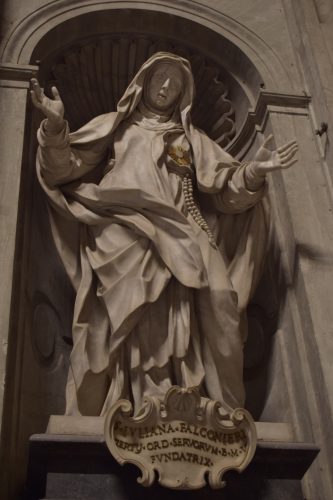One of four female Doctors of the Church, St. Catherine of Siena, is known for her writings on mysticism and spiritual guidance and her efforts for Church unity in the fourteenth century. We celebrate the feast of St. Catherine of Siena on the anniversary of her death, April 29.
Table of Contents
- Early life and vocation
- Sainthood
- St. Catherine of Siena prayers
- St. Catherine of Siena quotes
- Related prayers and saints
Early life and vocation
Caterina Benincasa, later St. Catherine of Siena, was born in 1347 in Siena, Italy, as the 25th child in a large family. Within a year of her birth, there was great turmoil in Italy due to the plague and continuing economic and military problems. The Church was also still in a state of conflict, as the Catholic papacy had moved to Avignon, France, in 1309, before Catherine’s birth. This period in Church history is known as the Western Schism.
Catherine experienced her first mystical vision – of Christ blessing her – at the age of 5. Two years later, she vowed to live a chaste life at 7. About a decade after, Catherine’s older sister passed away, and her parents urged her to marry her sister’s widower. Yet, despite her parents’ desires, Catherine refused. Instead, she entered the Mantellate, the female branch of the Dominicans of the Third Order, at 16 after her vision of St. Dominic.
Vowing a life of piety and chastity, she lived in silence and isolation for some years but soon turned to a more public life of prayer, activism, and spiritual counseling.
Sainthood
Catherine became known throughout Italy for her asceticism and efforts in church reform in her twenties. At 28, she received the stigmata (wounds resembling Christ’s from his crucifixion), similar to Padre Pio, St. Francis of Assisi, and St. Faustina Kowalska, among others. Religious art of St. Catherine of Siena often depicts her with the stigmata, such as the below sculpture.
Aside from her spiritual and mystic theological writings, namely The Dialogues, St. Catherine of Siena is most famous for her influence on Pope Gregory XI to reunite the Church in Rome. After residing in Avignon since 1309, the papacy returned to Rome in 1377; because of such efforts, Catherine is often referred to as a “Doctor of Unity,” in addition to her title as a Doctor of the Church. Pope Benedict XVI spoke to St. Catherine of Siena’s influence in 2010:
Today I would like to talk to you about a woman who played an eminent role in the history of the Church: St Catherine of Siena. The century in which she lived — the 14th — was a troubled period in the life of the Church and throughout the social context of Italy and Europe. Yet, even in the most difficult times, the Lord does not cease to bless his People, bringing forth Saints who give a jolt to minds and hearts, provoking conversion and renewal. Catherine is one of these and still today speaks to us and impels us to walk courageously toward holiness to be ever more fully disciples of the Lord.
Pope Emeritus Benedict XVI, General Audience on November 24, 2010
1380: Death
St. Catherine of Siena died of a stroke in 1380 at 33 years old – the same age as Christ on the day of His crucifixion. St. Faustina Kowalska also passed at 33.
1461: Canonization
Pope Pius II canonized St. Catherine of Siena in 1461.
1970: Doctor of the Church
St. Paul VI, then Pope, declared St. Catherine of Siena a Doctor of the Church in 1970.
1999: Co-Patroness of Europe
And in 1999, St. John Paul II, then Pope, named St. Catherine of Siena one of the co-patronesses of Europe, alongside St. Bridget of Sweden, and St. Teresa Benedicta of the Cross (Edith Stein). He spoke to her boldness,
With the same vigour, Catherine addressed Churchmen of every rank, demanding of them the most exacting integrity in their personal lives and their pastoral ministry. The uninhibited, powerful and incisive tone in which she admonished priests, Bishops and Cardinals is quite striking. It is essential—she would say—to root out from the garden of the Church the rotten plants and to put in their place “new plants” which are fresh and fragrant. And strengthened by her intimacy with Christ, the Saint of Siena was not afraid to point out frankly even to the Pope, whom she loved dearly as her “sweet Christ on earth”, that the will of God demanded that he should abandon the hesitation born of earthly prudence and worldly interests, and return from Avignon to Rome, to the Tomb of Peter.
St. (Pope) John Paul II, October 1, 1999
St. Catherine of Siena Prayers
“Come Into My Heart” Prayer
A short prayer to ask the Holy Spirit to draw near and lead us toward God’s love in our thoughts and actions.
Holy Spirit, come into my heart;
Draw it to Thee by Thy power, O my God,
And grant me charity with filial fear.
Preserve me, O beautiful love, from every evil thought;
Warm me, inflame me with Thy dear love,
And every pain will seem light to me.
My Father, my sweet Lord, help me in all my actions.
Jesus, love.
Jesus, love.
Amen.
“Love Undefiled” Prayer
A prayer of praise and thanksgiving that also guides us in asking for Him to lead us to His true Light.
Eternal God, eternal Trinity,
You have made the Blood of Christ so precious through His sharing in Your Divine nature.
You are a mystery as deep as the sea;
the more I search, the more I find,
and the more I find the more I search for You.
But I can never be satisfied;
what I receive will ever leave me desiring more.
When You fill my soul I have an ever-greater hunger,
and I grow more famished for Your light.
I desire above all to see You, the true light, as you really are.
Amen.
St. Catherine of Siena Quotes
“The human heart is drawn by love.”
“The soul is in God and God in the soul, just as the fish is in the sea and the sea in the fish.”
“There is nothing we can desire or want that we do not find in God.”
“If you are what you should be, you will set Italy ablaze.”
*This quote is frequently altered to “Be who God meant you to be, and you will set the world on fire.”

